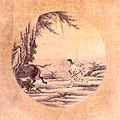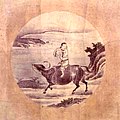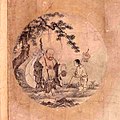The ox and his shepherd
The ox and his shepherd or, in the most common variant, the ten ox pictures ( Chinese 十 牛 圖 , Pinyin Shíniú tú ; Japanese 十 牛 図 jūgyūzu ; in some variants there are only five, six or eight pictures) is a motif from the Chinese tradition of Chan - Buddhism . The original variant consisted of a short verse with illustrative woodcuts. They describe or illustrate the spiritual path of a typical Zen Buddhist.
Although it is in the depicted animal is a water buffalo is (the Hanzi 牛 actually stands for " beef "), the name has Ochs photos enforced in the German language.
history
The basis for the still most popular picture cycle (a total of four have survived) was written and illustrated by the song- Chinese Linji - Chan master Kuoan Shiyuan ( 廓 庵 師 遠 , Kuòān Shīyuǎn , Kuo-an Shih-yuan ) around 1150. Chi-yuan later added a foreword and short forewords to each picture. This version was not widely used in China and Korea, but enjoyed great popularity in medieval Japan . In China and Korea, the earlier version of the Chan master Pu Ming ( 普明 , Pǔ Míng , P'u-ming ), which differs in many ways from that of Kuòān, was much more popular.
Kuòān's version was published in 17th century Japan along with Waka poems by Shōtetsu (1380-1458) in an anthology of Zen writings called Zenshū shiburoku , which was often used as introductory reading for Zen students. The originals from Kuoan have been lost. The prints by the hanga woodcutter Tokuriki Tomikichirō (1902–2000) are among the most popular versions of the ten ox pictures of today . In the West, the series of pictures was particularly through the translation into English by DT Suzuki (first in essays in Zen Buddhism: First Series in 1927 ) with illustrations by the priest Shūbun († late 15th century) from the Shōkoku-ji temple, who was active in the Muromachi period made known.
content
Below are the picture names of the Kuoan version, combined with the pictures of Shūbun:
According to Heinrich Dumoulin , the ox stands for the “real, deep self ” and the shepherd “for the human being ”. Dumoulin's interpretation of this parable of the "Zen process par excellence " is as follows:
“The shepherd has lost the ox and is standing alone in the wide field (1st picture), but can man lose his self? He looks for and sees the track of the ox (2nd picture), there is a mediation, a help in which religious things such as sutras and temple monasteries can play a role. Following the tracks, he finds the ox (3rd picture), but it is still only a distant, intellectual knowledge or intuitive feeling about the ox, he tames the animal with ardent effort (4th picture) and grazes it with careful vigilance ( 5th picture). These two stages include the practice in the zen hall, the hard, painful practice up to the grasping of enlightenment and the indispensable practice of the enlightened one. The practitioner gains full security, the shepherd swings on the back of the ox and, playing the flute, triumphantly returns home (6th picture), the joy of the shepherd and the raised head of the animal, which is no longer hungry for grass, show the attained full freedom. Both are now one, the shepherd in his freedom no longer needs the "ox", he forgets it, as, according to the famous word Chuang-tzu's trap and net become useless when the hare and the fish are caught. So the shepherd is alone without the ox (7th picture). Now both ox and shepherd disappear in the founding and comprehensive nothing of the circle (8th picture). When the shepherd appears again, all things around him are as they are (9th picture) - the everyday life of the enlightened one. And the shepherd comes into the city and into the market and gives presents to everyone around (10th picture). The enlightened one lives with all his fellow men and like all his fellow men, but the goodness that he radiates comes from his enlightenment. "
Single receipts
- ↑ a b Dumoulin 1985, p. 334.
- ↑ Dumoulin 1985, p. 261.
- ↑ a b Tetsuro Mori: The Kyoto School in Light of the Tradition of Zen Buddhism: From Zen's Ten Oxherding Pictures to the 'Logic of Locus'. In: The Bulletin of the Institute for World Affairs. Kyoto Sangyo University, No. 21, 2005, p. 108f.
- ↑ After Tetsuro Mori: Ecstasy and Expression - To Schelling and Nishida. Lecture at the International Schelling Congress in Tokyo and Kyoto in 2006.
- ↑ Dumoulin 1985, p. 261 f.
literature
- Heinrich Dumoulin : History of Zen Buddhism. Volume I: India and China . Francke-Verlag, Bern 1985, ISBN 3-7720-1554-9 , p. 261 ff.
- Rekidō Ōtsu (ed.): The ox and his shepherd: an ancient Chinese Zen story; with Japanese images from the 15th century (explained by Master Daizohkutsu R. Ohtsu. Translation by Kōichi Tsujimura and Hartmut Buchner). Neske-Verlag, Stuttgart 1995, ISBN 3-7885-0236-3 .
- Bogdan Snela (ed.): The ox and his shepherd: Zen moments (with comments and selected texts by Hugo M. Enomiya-Lassalle . With ink drawings by Tatsuhiko Yokoo and calligraphies by Yoshiko Yokoo. German translation of the texts for the 10 ox pictures by Guido Joos). Kösel-Verlag , Munich 1990, ISBN 3-466-20325-2 .
- Zenkai Shibayama : Zen in parable and picture [Japan 1970], Bern-Munich-Vienna: Scherz-Verlag 1974
Web links
- Texts: Kyosho No. 245 - 259 (born 1994–1996), revised version; Pictures: Works by Yokoo Tatsuhiko , member of the Sanbōkyōdan Society [1]
- Texts: Zen Guide Germany [2]
- Texts: According to the book: Zen and the culture of Japan: Monastery life in Kyōto., Ed. By Claudius Müller; Image: probably Shūbun, Shokuku-ji, Kyōto, Japan [3]
- Paul Reps , Nyogen Senzaki : Images and text in English, from: Zen Flesh, Zen Bones: A Collection of Zen and Pre-Zen Writings. Anchor Books, Garden City, NY 1957. (Reprinted from Penguin, London 2000, ISBN 0-14-028832-5 )
- Ox pictures of the Zen Mountain Monastery
- Ten Oxherding Pictures - the ten illustrations attributed to Shubun









